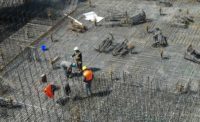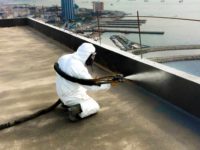Positive vs. Negative Waterproofing: Where, When and Why


Prior to designing waterproofing for a new building, the architect is faced with a plethora of questions. The initial question is “Where do you want the waterproofing to be installed?” The choices are:
- Positive side waterproofing.
- Negative side waterproofing.
- Integral waterproofing.
Integral waterproofing is comprised of admixtures that are incorporated into the concrete mixture during the initial pour. These types of products are very vulnerable and are not considered for discussion in this text.

Positive vs. Negative: Where
Positive side waterproofing is applied to the wet or exterior face of foundations or slabs on grade and below grade, as well as suspended slabs. It is the predominant type of waterproofing used in new construction. Positive side waterproofing applications consist of all commercially available dampproofing or waterproofing systems. Properly applied positive side waterproofing protects the interior of the facility from moisture infiltration and protects the structural components, including concrete and steel. Positive side below-grade systems include fluid-applied membranes, sheet-membrane systems, hydros clay and vapor barriers.
One of the primary advantages of positive side systems is that water is prevented from entering the substrate surface. The substrate is also protected from freeze-thaw cycles, as well as from corrosive chemicals in the groundwater.
The primary disadvantage of positive side waterproofing is that the system is inaccessible for repairs after the installation. This means that costly removal of topping (concrete, landscaping, grass, dirt, etc.) is required prior to repair - no matter how small the area of repair is. Another disadvantage is that subslabs and well pointing are required for foundation waterproofing.
Negative side waterproofing is applied to the dry or inside face of the subsurface. It is used primarily for water holding purposes. Negative side waterproofing prevents water from entering occupied space.
However, it does not prevent water from entering the substrate.
The materials used in negative side waterproofing applications must be able to withstand hydrostatic pressure. The most common forms of materials used in these applications are epoxy injections and cementitious coatings.
There are also acrylic or crystalline chemical conversion additives on the market that are applied at the blind side and penetrate into the substrate.
The primary advantage of negative side waterproofing is that the area is fully accessible after installation. Any further defects or required touch-ups can be repaired with no surface removal or intrusion to the substrate. This method also eliminates the need for subslabs and well pointing for foundation waterproofing, which are required on positive side systems.
Moisture entry allowed into the substrate on negative side waterproofing systems can be viewed as both an advantage (it promotes active curing of the concrete substrate) and a disadvantage (it contributes to the corrosion of the concrete and steel reinforcements from groundwater and chemicals). Negative side waterproofing does not provide protection from freeze-thaw cycles and is limited to the application of cementitious systems.

Positive vs. Negative: When
The decision to use positive side or negative side waterproofing can be made after exploring a litany of questions regarding site conditions:
- Will there be exposure to corrosive soil materials? If so, consider only positive side waterproofing.
- Will there be exposure to freeze/thaw cycling? If so, consider only positive side waterproofing.
- Will there be interior humidity limitations? If so, consider only positive side waterproofing. If the answer to all of these questions is no, then negative side waterproofing can be considered.

Positive vs. Negative: Why
Most waterproofing experts agree that the most effective form of new construction waterproofing installation is at the positive side of the structure. The installation of any system on the negative side is exposed to the added risk of having the waterproofing “pushed off” or disbonded from the substrate by moisture that infiltrates the concrete in a liquid or vapor form. Waterproofing applied to the negative side of the structure also provides a passage for any ground containments or chemicals to enter into the substrate and deteriorate the concrete and corrode steel reinforcements.
To eliminate these concerns it is possible (although not always economical) to install a negative side bulkhead wall to hold the waterproofing in place. This method may prove to be more costly than excavation of the surface. The optimum solution is to apply positive side waterproofing on newly constructed structures and limit negative side waterproofing to remedial applications.
Looking for a reprint of this article?
From high-res PDFs to custom plaques, order your copy today!





